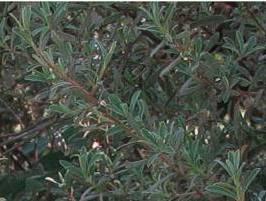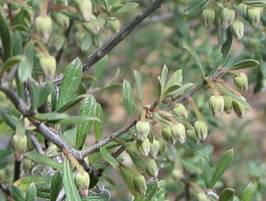Diospyros austro-africana
Diospyros austro-africana De Winter
Family: Ebenaceae
Common names: fire-sticks, star-apple (Eng.); kritikom, jakkalsbos, vuurmaakbossie, kraaibessie (Afr.); liperekisi-tsa-makhoaba, senokonoko (South Sotho), umbhongisa (Xhosa)
SA Tree No: 602.2
Introduction
Diospyros austro-africana is a beautiful indigenous shrub or small tree that bears little cream, pink and even red lantern-like flowers. Not only attractive to man but also to birds and butterflies, it grows in different regions and conditions across the country.

Description
Description
Diospyros austro-africana is a multistemmed shrub or small tree, somewhat rounded, 2 to 10 m high. The bark is medium to dark brown with fine, flakey strips. The brown branches are finely haired, similar to the fine hairs on the small, narrow-obovate leaves which give this shrub a dusty grey appearance.

The leaves are whorled and crowned at the tips. They are 35 x 2-5 mm, subsessile, oblanceolate, slightly darker and velvety on top and felted beneath.
The flowers are pendulous, creamy white, cherise-pink or red. Each flower is surrounded by a 5-lobed calyx which holds the developing fruit and is unique to Diospyros. Plants are dioecious, either male or female. Flowering time: August to November.

Round, fleshy fruits are borne from January to June. These are also velvety and ripen red to black. The fruit is usually 15 mm in diameter.
Conservation Status
Status
Diospyros austro-africana is not a threatened species.
Distribution and habitat
Distribution description
There are four varieties of Diospyros austro-africana (a variety is a natural subdivision of a species):
var. austro-africana occurs in the Western Cape regions and north towards Namaqualand;
var. microphylla is the most common and widespread, occurring in the Western Cape, Northern Cape, Free State and further north of the Vaal River;
var. rubiflora occurs inland from the Free State, Lesotho to KwaZulu-Natal;
var. rugosa occurs in the Western Cape.
Generally this is a water-wise plant that can tolerate cold temperatures and severe frost. It is suited to the winter rainfall regions of Western Cape, KwaZulu-Natal and northern South Africa.
Derivation of name and historical aspects
History
Diospyros austro-africana belongs to the family Ebenaceae. It was previously known as Royena hirsuta. There are two genera in South Africa, Diospyros and Euclea.
The common name of the genus Diospyros is persimmon or tolbos. It is characterized by: the calyx (composed of sepals) which usually increases in size after flowering; the ovary is borne on a smooth, hairless disc; fruits carry 2 or more seeds; leaves are alternate.
There are 500 species in the genus and these are found in pantropical and tropical areas. Diospyros is derived from the Greek, dios meaning divine, and pyros meaning wheat or grain.
Ecology
Ecology
Diospyros austro-africana is water-wise with characteristics such as tiny leaves and felt-like hairs.
Speckled and Red-faced Mousebirds, Black-collared, Pied and Crested Barbets, Black-eyed Bulbuls and Red-winged Starlings enjoy the fruits of this shrub. The flowers attract insects and they are eaten by Southern Boubou, flycatchers, white-eyes, robins and thrushes. The larvae of the Natal Copper butterfly feed off this plant.
Uses
Use
The wood of Diospyros austro-africana is used to make fire. The fruits are also edible. This shrub has good potential as a bonsai.

Growing Diospyros austro-africana
Grow
Even though this plant is considered water-wise, moderate watering will benefit it, as well as a good potting mix with compost. Diospyros austro-africana is slow growing, a good rockery plant and can be used in a mixed border or as a screening shrub.
It is grown from seed. Propagate from seeds as the cuttings are very difficult to root. Fresh seeds grow much better than stored seeds. Collect the seeds when ripe and clean them as soon as possible. Use 50% sand and 50% seedling mixture in the trays. Cover the seeds with the mixture. Place the trays on hotbeds and do not allow them to dry out.
The seeds will germinate within three weeks. After a week of germination, allow the seedlings to harden off. Seedlings can be transplanted after a month in the hardening off area or can stay in the seedling tray for years. The plants need full sun and well-drained soil.
References
- Coates Palgrave, M. 2002. Keith Coates Palgrave Trees of southern Africa, edn 3. Struik, Cape Town.
- Goldblatt, P. & Manning, J. 2000. Cape plants. A conspectus of the Cape flora of South Africa. Strelitzia 9. National Botanical Institute, Pretoria and Missouri Botanical Garden.
- Joffe, P. 2003. Indigenous plants. Briza Publications, Pretoria.
- Leistner, O.A. (ed.). 2000. Seeds plants of southern Africa: families and genera. Strelitzia 10. National Botanical Institute, Pretoria.
- Pooley, E. 2003. Mountain flowers, a field guide to the flora of the Drakensberg and Lesotho. Natal Flora Publications Trust, Durban.
Credits
Leanne Wels & David Rambuwani
Free State National Botanical Garden
November 2008
Plant Attributes:
Plant Type: Shrub, Tree
SA Distribution: Eastern Cape, Free State, Gauteng, KwaZulu-Natal, Mpumalanga, North West, Northern Cape, Western Cape
Soil type: Sandy, Loam
Flowering season:
PH: Acid, Neutral
Flower colour: Red, Pink, Cream
Aspect: Full Sun
Gardening skill: Average
Special Features:
Horticultural zones











Rate this article
Article well written and informative
Rate this plant
Is this an interesting plant?
Login to add your Comment
Back to topNot registered yet? Click here to register.